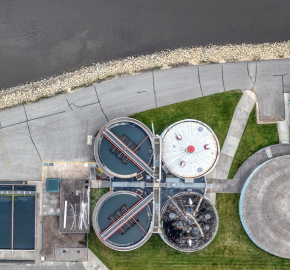Cunliffe Review Interim Report – does it make any difference?

Although some eNGOs welcome the Cunliffe Review’s interim report [1] on the water and sewage industry, whilst urging it to go further, [2] we are more circumspect.
The Terms of Reference of the Commission, articulated with little modesty, are advertised to be “wide, multi-dimensional, and detailed.” However, as our response to the “Call for Evidence” says, the reality is one of a vague, long collection of issues with no guarantee of pragmatic resolution.
The interim report does nothing to increase our confidence.
Public trust, we are reminded in the interim report, “has been shaken – by pollution, financial difficulties, mismanagement, infrastructure failures, and by a sense that decisions affecting people’s daily lives are made too far from their communities, that local voices are lost. Restoring that public trust is paramount.”
Of course, the public will need to wait for the “full conclusions and recommendations” of the final report, but the interim report “sets out. . .preliminary conclusions in a number of key areas”.
The document, at over a hundred pages, covers a wide range of subjects. But it gives relatively few hints at concrete recommendations and the “preliminary conclusions” leave the reader none-the-wiser.
The headings cover five areas: “Strategic Direction and Planning”, “the Legislative Framework”, “Regulatory Reform”, “Company structure, ownership, governance and management” and “Infrastructure and asset health”.
There can be few objections to the anodyne recommendation given to the first item – “Strategic Direction” – that “the sector needs a clearer and more consistent long-term direction – one that aligns environmental ambition, the provision of water supply and wastewater removal, and the expectations of customers.” Crucial to this is a “more effective planning framework” with a local or regional aspect supported by a “national coherence” and “better integrating all of the sectors that impact on and interact with the water environment, including farmers.” None of this is controversial as it is so light on detail. But how can any of it be achieved?
The meat of the report is not clear on answers. It prescribes a more long- term strategic direction from government. That is all very well, but what are the options apart from high level directions from the Secretary of State? We only get un-examined options. Does the system need more committees? Maybe. Or maybe existing ones could be used. Should the coalition of plans be achieved at water catchment scale? Or would it be better democratically to organise around local authority areas? Which processes should be combined?
What the interim report fails to do by virtue of its unwieldy mandate is to catch the nuances of the existing complex relations of local government and water companies, for instance, in addressing the capacity of the system to deal with (and plan ahead for) more housing and the demand for services. In a sense, the Commission cannot possibly deal with more than a few areas in the time given and this area alone is complicated enough.
As for the second item in the report: the legislative framework – it apparently needs “revisiting” as it is far too complex and “difficult to navigate” with “around 80 items of water legislation applying in England and Wales”. What the report fails to mention is that not all laws apply all the time and many are very specific to the areas they cover.
The answer posited loosely by the Commission in the interim report is that “a streamlined, and more focused legislative framework could clarify lines of responsibility and remove any ambiguity around purpose“. The report admits, however, that the wholescale “review and rationalisation of extensive legislative framework would be a major exercise requiring public consultation and considerable scientific and technical expertise” though the Commission will indicate “priority areas for review”.
If the examples chosen for reform are anything to go by, it does not leave us with much confidence. Alarmingly, one priority area is the Water Framework Directive Regulations (WFD) which, we are informed, need rewriting. The chosen case study is from the Environment Agency (EA) which apparently opines that if new reservoirs for water storage need to meet the WFD objectives, then they will never be built (see “Box 5”). But that it is plainly wrong as the WFD regime allows for exemptions for meeting targets when they are for reasons of overriding public interest or where there are public benefits, for instance, in building such reservoirs (see WFD Article 4 (7)).
There is also the extraordinary suggestion of broadening WFD to take into account non-environmental objectives such as public health and recreation – despite the fact that there will be an obvious clash of aims. It is remarkable that the review fails to acknowledge that public benefits are already allowed for in the current legislation as exceptions to the environmental objectives.
As to the enforcement of the law, the answer is, apparently, “constrained discretion” (defined loosely here as “flexibility to support decisions that allow for innovation, such as nature-based solutions, while maintaining clear accountability”). Read into this that there will be less enforcement where, in practice, there is already far too little (hence the public outcry at continued pollution of rivers).
The third area for consideration is “Regulation”. The interim report proffers a more “supervisory approach” to water companies, “one that combines strategic oversight with a deep understanding of company-specific contexts” with “earlier, more active engagement by regulators”. One key concession is funding: “the Commission is clear that the water sector regulators need to be properly resourced to carry out their functions”. If such a recommendation is taken seriously by government, then there is at least a chance that the regulatory and enforcement functions can be improved.
As for the structuring and modelling of water companies, the direction of travel is for modification rather than a fresh start. At a time when Thames Water investors are walking away from a heavily fined and discredited company, the Commission insists that water and sewage companies “must be made more attractive to stable, long-term investors. As effective monopolies providing an essential public good, it is appropriate that water companies should present relatively low risks and consequently offer relatively low returns.”
To attract long term investment, we are told, “risks also need to be lower than they are presently. In large part, this means restoring confidence in the stability and predictability of the regulatory system.” But the answers provided in the interim report are thin and unexplained.
There is a real dilemma here. The commercial structure is needed to attract investors. But we are not starting from an original position with blameless water companies, but ones with “history” and current liabilities.
The detail on how risk will be reduced is, of course, lacking – though we are promised recommendations in the final report.
As for the ageing assets and infrastructure at a time of regular reports in the media of discharging and leaking pipes “resilience must be brought to the fore” – “not as a technical afterthought but as a strategic imperative. An infrastructure resilience and asset health framework is required to ensure that we do not just fix failures when they occur but rather responsibly plan for the long-term condition and performance of critical assets.” That is certainly a crucial recognition by the Commission. But it is not fully explained how this approach sits with or replaces the AMP process or indeed how this can ensure that the regulators do what they are required to do to (for instance) over and above the enforcement of the existing duties for ensuring the proper treatment of sewage under s 94 of the Water Industry Act 1991.
In all, the jury is out on the effectiveness of the Commission and there is a real lack of clarity as to how recommendations will be put into practice.
Most worrying of all is that the growth agenda makes its appearance in the interim report, especially in the call for the use of “constrained discretion” by regulators. The report cross-references the Dan Corry review (see blog post: what do we make of the Corry Review) which is by and large a call for de-regulation. At a time when the government is proposing the weakening of the laws that keep sensitive species and habitats safe through its Planning and Infrastructure Bill (see more here), there is not much to celebrate in this or any other proposals from the government and its advisers.
List of references
1. Click here for details of the Water Commissions Interim Report
2. Wildlife and Countryside Link: Government must follow Cunliffe recommendations and then go further to fix failing water system




